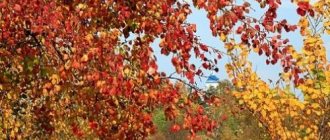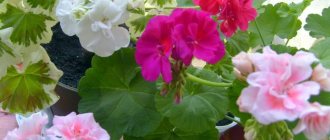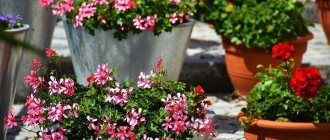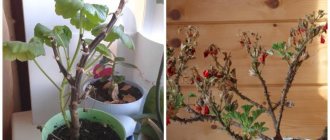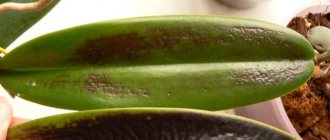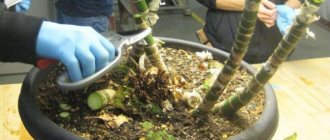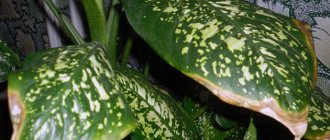Geraniums have become increasingly popular in recent years, as the flower is associated with home comfort. The plant is noteworthy because in winter it decorates the windowsill, and in summer it can be used to decorate a summer cottage. Even novice gardeners can easily cope with growing pelargonium due to the fact that the plant is quite unpretentious in care and quite resilient. But, like all plants, sometimes geranium is subject to various diseases, one of which is reddening of the leaves. There are several reasons why geranium leaves turn red.
Features of indoor flower growth
Before purchasing any plant, first of all, you need to study a large amount of information: what soil it prefers, where it is better to plant, what fertilizers it likes, how to water it. All these questions should be answered in advance so that later you do not have to solve problems due to a mistake in care.
There is no specific answer to the question of why the leaves of a flower turn red. Just when growing a flower you should take into account the specific care.
In decorative floriculture there are several varieties of the geranium family:
- photophilous;
- shade-loving;
- shade-tolerant;
- drought-resistant.
Therefore, despite the unpretentiousness of the plant, it is important to understand that each type of geranium requires the right approach. If light-loving pelargonium is planted on a north window, it will eventually get sick or die.
The most striking indicator of successful growth is appearance. Withered inflorescences should be removed, young shoots should be pinched to speed up growth and flowering. Annual pruning will help maintain the aesthetic appearance of geraniums.
No flowering
- The pot chosen is too large, so all efforts are directed towards root growth.
- Geraniums enter a dormant period, most often in the fall. This is normal and nothing to worry about at all. Just wait until spring.
- You did not give the flower a winter rest. And therefore the plant has not accumulated enough strength for lush and vigorous flowering.
- Geranium is not provided with favorable conditions for growth and development, which were described above.
We recommend that you read our other articles about what causes leaf diseases in geraniums and how to help the plant if its leaves curl and turn white.
And in conclusion of all of the above, I would like to remind you that any plant, despite all its unpretentiousness, requires decent care . Therefore, always try to get as much information as possible about the contents of a particular flower. And I hope that our articles will become your constant assistant and adviser in this.
Why did the redness occur?
Along the edges
Cold air in the room. Temperatures below 18 degrees can cause geraniums to freeze. For this reason, pelargonium leaves may turn red around the edges and then fall off completely. If the plant is standing on a cold window, then it must be removed from there.
Why might red spots appear in summer on a plant grown outside? If geraniums are grown outdoors, then cold summer nights can also trigger their formation. In this case, it is better to take pots of flowers home at night.
If the plant is planted in open ground, then the only correct solution is to transplant it into a pot and move it into the house overnight.
Partial in the form of spots
Excessive lighting.
Most often in spring, the leaves turn red due to an excess of sunlight. It is the old leaves that change color; the young leaves can withstand bright sunlight perfectly. In this case, you just need to move the pelargonium away from the window.- Overmoistening of the soil.
Excessive watering can cause root rot. Red spots on the leaves can indicate its presence. Fungi Rhizoctonia and Fusarium are the main causative agents of this disease. Symbiont species of these fungi are formed in the soil at the root level when waterlogged. A healthy flower is not susceptible to infections.Overhydration causes weakened immunity. Fungi attack the root system of a weakened plant. As they rise into the trunk, its color changes from green to brick red.
The leaves located in the lower tier of the plant are infected first. Red-orange and red-brown stripes appear on them. Root rot damage leads to nutrient deficiency, as the supply of vitamins and essential substances to the upper part of the plant slows down. Therefore, pelargonium begins to gradually wither and further die.
- Lack of nutrients.
The reason may be a high pH level or high electrical conductivity of the soil. The quality of water, method of watering, shape and size of the pot greatly affect the absorption of nutrients.The reason for the formation of pink or red spots and streaks can be a lack of nitrogen, calcium and boron. Signs of deficiency can be detected 2–6 weeks after its onset.
- Nitrogen deficiency.
Nitrogen promotes vegetative growth of the plant. Its deficiency inhibits the development of geranium leaves. With insufficient nitrogen supply for a long time, pelargonium may develop chlorosis of the lower leaves. Signs of this disease are pigment spots on the leaves and their curling. If nitrogen reserves are not replenished, over time the leaves will begin to die. - Zinc deficiency.
Zinc deficiency manifests itself in stunted plant growth. Young leaves growing in the upper tiers of geraniums are susceptible to the disease. The shedding may change shape and develop pink or red pigmentation. The plant stops growing.
On the back side
Phosphorus deficiency. With a lack of phosphorus, the edges of the lower leaves may become covered with red spots, which dry out over time.
The geranium leaves turned red outside, why is this happening?
Why do geranium leaves turn yellow at home - causes and treatment
Garden crops are not protected from low temperatures. With frequent watering, the flower can negatively tolerate excess moisture, which is expressed in the form of fungal diseases. The plant becomes covered with red foliage if it is planted in open areas that are not protected from direct sunlight during the day.
Problems of growing garden geraniums
Important! To prevent the leaves from turning red, the plant should be placed indoors on a windowsill.
Detailed instructions: what to do to help the plant?
Detailed instructions:
The first thing to do is check the soil moisture. If the soil is found to be excessively wet, then it can be assumed that the cause of the redness is normal overwatering.- Review the conditions for growing a flower regarding a specific type of geranium. If they are not met, then they should be brought back to normal. Dry air, high air temperature, excessive or insufficient watering, low or excessive light - all this is stress for the plant. It is known that during times of stress, nutrients can be absorbed worse and longer.
- Test the soil for pH levels. It should be between 5.5 and 6.5. It is this level that allows microelements to be absorbed normally. If the range is not respected, it is necessary to adjust the acidity of the soil.
- Next comes a check for the presence of any infection (what leaf diseases are found in geraniums?). To do this, cut off the top of the stem and inspect the cut. If it is green, we can conclude that the upper part of the plant is not affected. If a brown color is detected, there is no need to save the plant. It will not be possible to revive him.
- If the outcome is favorable, when the geranium can still be saved, it needs to be replanted in new soil.
In order to protect pelargonium from new diseases, the soil mixture should be disinfected. You can do this in several ways:
- Heat for 30 minutes in the oven.
- Scald with boiling water.
- Treat with fungicides (Planriz, Glyokladin, Gamair, Extrasol, Fitosporin-M, Alirin-B). Processing will not be difficult. To do this, you need to place one tablet of Gamaira and Alirin in a glass. The volume of the solution should be 10 liters. Pour the resulting mixture into the soil, cover it with film, only after three days can the soil mixture be used for replanting.
Algorithm of actions during transplantation:
- Remove the geranium from the pot and clean the roots from the soil.
- Inspect the entire root system. If rotten shoots are found, they should be removed.
- If the geranium blooms, then it is necessary to pluck out the inflorescences.
- Pour soil into the pot, place the geranium in the center, sprinkle soil on top, which needs to be slightly compacted.
- Place the flower in a dark place for several days.
- Every two days it is advisable to spray pelargonium with Zircon.
- After one week, the geranium can be placed on an east-facing window.
- After another week, it is recommended to feed the plant with Kemera solution.
Geranium is valued not only for its beautiful appearance, but also for its ease of care. However, sometimes it happens that the fragrant leaves begin to turn yellow and fall off. From the materials of our experts you will learn why this happens and what to do about it, as well as why the flower dries up, withers and the leaves turn white.
What to do if geranium turns yellow and dries out
Preventing the appearance of yellow leaves in royal pelargonium is quite simple. This requires a review of the rules of care that were applied before. First of all, it is worth considering that geranium is a light-loving flower, and therefore the pot with it should be placed on a sunny windowsill with diffused light.
The air temperature in the room should be average, about 15 °C. Dry and fresh air is the optimal environment in which to keep the plant. However, it is not recommended to allow the flower pot to be exposed to a draft. If diseases and harmful insects are detected on geranium, it is necessary to immediately begin treatment with special means.
Important! Transplantation is carried out after the previous pot has become small
Fertilizing against yellow and dry leaves
Feeding is an important part of the life of geraniums. You need to choose fertilizers depending on the life cycle of the flower. To grow greenery, it is worth adding nitrogen to the soil, for growth - potassium, and for flowering - phosphorus. It is recommended to introduce liquid fertilizers into the soil after watering so as not to burn the root system. To prevent yellowing and drying of the leaves, it is worth adding the following supplements from folk recipes:
- Hydrogen peroxide will help even if the flower has begun to fade. This remedy relieves diseases if used in combination with other special solutions. To prepare the solution, you need to take 25 g of the substance per 1 liter of water. It is recommended not to introduce it into the soil, but to spray it on the plant;
- Milk can be used to strengthen the plant. It is dissolved in a liter of well-settled water at room temperature. Watering with this solution should be alternated with regular ones;
- To stimulate the growth of geraniums, you can use castor oil. Mix a teaspoon of the product with a liter of warm water and spray the leaves of the flower. The solution can be used for watering. It is recommended to start using during flowering and budding.
Not every gardener knows what to do if geranium leaves turn yellow and dry. You need to act depending on the cause of this symptom. It is definitely worth learning how to properly care for the plant, since these mistakes can harm it in more cases.
Preventive measures
To prevent pelargonium leaves from turning red, you need to take preventive measures. These include: disinfected, high-quality soil, proper care. There is nothing difficult about following these measures.
Before purchasing geraniums, you need to take care of the soil mixture and a pot of the required size.- Even in the store, you should carefully inspect the cuttings for diseases. Doubts about the absence of diseases can be considered a reason to refuse a purchase.
- Before planting, planting material should be soaked in a fungicide solution.
- Filtered water should not be used for irrigation. Passing through the filters, it loses all the microelements necessary for the plant.
- Do not forget to feed pelargonium once every two months with universal fertilizers.
Proper care and disease prevention are the key to plant health. Simple rules will help you achieve lush, long-lasting flowering of geraniums.
Prevention
Of course, preventive measures will protect the crop from the appearance of redness on the leaves. Preventive measures are as follows:
- Young crops (up to 3 years old) are replanted every year in early spring. For mature plants, one update every two years is enough.
- Select a pot of suitable size - the root system should not be crowded, but at the same time not very loose (the pot is 2 cm larger than the rhizomes).
- In winter, give the flower a rest. To do this, the frequency of watering and fertilizing is reduced, and the pot is moved to a dark place with a temperature of 17-20 degrees above zero.
- From the beginning of geranium flowering, provide it with potassium and phosphorus feeding every two weeks.
- With the onset of spring, prune and pinch the bush.
- After transplantation, do not feed geranium for the first month. At the beginning of autumn, reduce the frequency of fertilizing to once a month.
Important! During the procedure, pay attention to all parts of the plant, removing dry and damaged leaves and shoots.
Geranium is an unpretentious plant and does not require special care. But the basic aspects of cultivation still need to be taken into account and carried out. With proper care, the crop will delight the grower with rich greenery and lush flowering.
Nitrogen deficiency
Nitrogen is needed for vegetative growth of the plant. With its deficiency, the growth and formation of the plant is delayed. Leaves are especially affected. When a plant does not receive enough nitrogen over a long period of time, chlorosis of the lower leaves may form. Scarlet pigmentation appears on them, the edges of the leaf blade are bent downwards. With subsequent starvation, the edges become brown, the leaves dry out and die. Leaf chlorosis can be cured by changing the soil environment (correcting the imbalance of substances), or by introducing iron compounds
Diagnosis of the problem
Small light spots appeared
- Clear yellow spots with smooth edges on the front side of the sheet, and on the inside a brown coating is rust, which often appears if the air is warm with high humidity.
- A small fluff on the leaves, light spots, while the plant becomes lethargic and unattractive with dark formations on the leaves - this is Botrytis, a parasitic fungus. The disease appears from excess humidity.
- A ring pattern on pale green spots that gradually merge, while the plant stops growing and developing, flower stalks do not form - this is ring spotting. The cause of this disease is nematodes living in the soil.
- Another serious infection is the appearance of spider mites. Yellow spots appear on the leaves, they gradually begin to fall off, while the plant seems to be entangled in a small, barely noticeable web.
Brown drawings
- Brown spots appeared on the lower leaves - this is gray rot; if the plant is not treated, then over time the spots become covered with a gray coating, which tightly covers first the geranium leaves, then the stem.
- If a light spot appears in the middle of the brown spots, then this is Alternaria blight. The disease manifests itself as follows: the leaves turn yellow and dry out, while the plant stops gaining color. If the air humidity is high, then all parts of the geranium become covered with a velvety coating.
- Red-brown spots indicate that the plant is in direct sunlight, while the air temperature is much lower than optimal (why do geranium leaves turn red?).
Overmoistening
90% of plants in the Geranium family are drought-resistant, so they do not need abundant and frequent watering. In this case, redness may indicate root rot, caused by a fungus. It lives on roots. But when the plant is healthy and has good immunity, it is not afraid of infections. Overwatering weakens the immunity of geraniums, thereby making them vulnerable.
The first external sign of this disease is dark red stripes on the lower leaves. What does this lead to? A root infected with a fungus does not sufficiently supply the plant with nutrients, which can lead to slow growth and wilting (read about what to do if a geranium in a pot withers and why this happens here). In this situation, you need to reduce the abundance and frequency of watering, and the growth and development of the flower will return to normal.
Blood red geranium in garden design
Low-growing varietal forms of blood-red geranium are used in rock gardens, flowerpots, and roof landscaping. It is planted in groups and alone in rockeries, borders, and mixborders. Group plantings of low varieties of blood-red geranium are good as lawn substitutes. In flower beds and rock gardens, geranium goes well with mantle, garden chamomile, bells, heuchera, hosta, and daylily.
Image source flickr.com: Yovenn PEIGNET, dominique evrard (10), Sylvain Burgaud, Lesley Baker, Madelein Vreeken- Buijs, Rictor Norton & David Allen, geert.lambrecht, John Hagstrom, katesmudges~, Kingsbrae Garden, JardinsLeeds, Ben Rushbrooke, Stadtkatze, meconops, jim.a.macdonald, Old Lodger, Gary Vause, Sarah Miescher, arbolz, Dan Kristiansen, naturgucker.de / enjoynature.net (3), Janet, Eglė K., Graham Gibbs, Dan Kristiansen, vega, Mókus Jeff Collman
